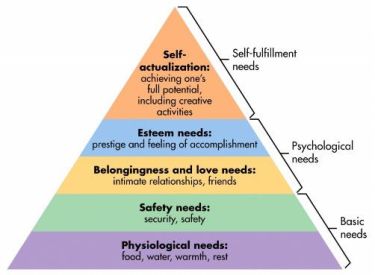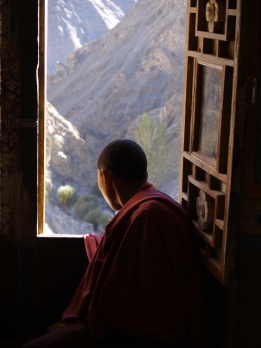The majority of you is presumably aware of the idea behind the pyramid of needs created by the Psychologist Abraham Maslow. However, for the sake of the argument and the complexity of topic, let us quickly go through it again. 
The pyramid is set up of five layers. Starting with our physiological needs, such as food, water, sleep and shelter. Moving up one layer, we have security and safety. These two bottom layers are referred to as basic needs, followed by the third and fourth layers that include the need for belonging and esteem, which are summarised under the title psychological needs. To conclude, the third category, self-fulfilment needs describes our creative potential.
We can say, that by creating a pyramid with its different elements, Maslow has adequately and in a genuinely simple way described, what defines us as human beings. We need food and water to survive, social contact and human connection and once these are satisfied, we focus on ourselves as an individual, wondering who and what we want to be.
Before focusing on the highest component of the pyramid, we should explore the workings of the pyramid en detail and some possible misleading aspects that come as a result of its simplicity. First of all, its hierarchical structure. We assume that just as with any hierarchy, once we move up the ladder our needs change and we need to satisfy the lower components first in order to be able to move up to the top, but it is not that simple.
In some situations, we might forgo basic needs for the sake of higher needs. A good example is a soldier, who goes to war for his country, risking his life for some higher ideal, such as spreading democracy. We can debate whether these ideals are true and right, but to what they do lead is that someone is willing to die for them, although it is against our basic needs of survival and safety. One could even argue that by forgoing these simple needs for the purpose of self-actualisation makes these actions extremely powerful and presumably more effective.
Let us look at another example that is illuminating in this case and follows this exact line of argument.

“Monks and nuns forgo to a certain level basic needs of human relationship to dedicate their main energy onto ‘higher’ needs”
Monks and nuns, at least this is what they have pledged, forgo to a certain level basic needs of human relationship by not being allowed to marry or live in a relationship and having sexual intercourse. The argument is that they can dedicate their main energy onto ‘higher’ needs in the study and the teachings of the religious texts. So it seems, although we are looking at a hierarchical structure it does not always apply and in the case of certain ways of life this is not only a temporary condition as it is usually for the soldier, but absolute over the entire course of your life, if you take the example of the monk.
This brings us to the primary question in this article. Who do we want to be and as what do we define ourselves? I think we can all agree that we do not define ourselves by what we eat and drink, although the French might disagree. It is not necessarily our basic needs that do set us apart and make us an individual, but rather the advanced needs of esteem and self-actualisation.
So let’s look at the other aspects. Presumably, we can say that to a certain part we define
ourselves and are defined by the people we are surrounded by. Hence, there is a component of us as an individual that is externally determined. Although, we can choose our peer groups, what we cannot is our upbringing, the social context, we are raised in and the values we are taught. To a degree this might actually influence also our peers and friends we match with. So in practice we do not really have a choice, we match with whom we match. Of course, we are being a little extreme here. Our social context, values and contacts might evolve and change over time, but we can certainly assume after a certain age this is relatively set. It is commonly acknowledged that in western societies, this point arrives at the age of 25, after which our personality is shaped and we will only change if extreme circumstances require us to, as it involves self-doubt and a high degree of effort.

“Just like Tom Hanks in Cast Away creates Wilson out of an old volleyball, we create a social environment around us”
We can therefore say that to a certain degree we are who we are through the people we hang around with. This eludes to human beings as social animals that need human connection for survival (*even monks do not entirely forgo this component, their community in the abbey is actually fairly strong and flourishing). For meditation purposes and other reasons, we might temporarily isolate ourselves from society, but in most cases this is not something that is ever lasting. Just like Tom Hanks in Cast Away creates Wilson out of an old volleyball, we create a social environment around us, not for mere amusement, but out of the fundamental need of belonging.
So, we have already unfolded one aspect that defines who we are, but generally we associate more with the question of who we are and it is certainly more multifaceted.
Another possible component, leaning towards the esteem layer, are our achievements. A great part of our life’s efforts go into attaining a certain goal and once we have achieved it, we usually find another. This keeps us going, growing and instils a certain drive in us.
We can even say a part of us is reflected in our achievements. For example, if we aim to become fluent in a foreign language, we invest a great deal of energy and time into it, until we have achieved it. During the process, we become more and more emotionally involved in the project. This is the case with anything. Your job, you education, your sports and other hobbies you might pursue. Thus, we can say, our personality is not only defined by who we are, but what we do, our actions. So, it does not only have a conceptual component, but also a very practice oriented one.
The next element of our personality is arguably more abstract. With the esteem layer, we have already moved beyond the basic psychological and physiological needs, now it gets truly interesting. Our esteem needs drive us to certain types of actions, whereas self-actualisation is the least tangible aspect. Usually it is difficult to measure or put into concrete terms. For esteem needs, we can easily do so, there are certain parameters on which we can measure our success, e.g. whether we can speak the foreign language not only in a social, but also in a professional environment, whether we play football well enough to join the national team. Especially in sports, we can easily quantify our achievements, for instance how many goals have we scored over the season versus the national average.
We would argue that the self-actualisation element is contributing to our personality in a different way. It first starts with actually asking the question itself. Self-actualisation about asking the precise questions we are tackling in this article. Who am I and who do I want to be? Only be asking these self-reflective questions, we can derive actions that get us to where and who we want to be.
This contemplation in a Kantian sense using reasoning and reflection ultimately makes us a more open, deliberate and well-crafted person. Only by possessing the necessary liberation from our other needs by having achieved them, we reach the desire to sharpen our personality and wonder actually who we are and who we want to be. We do not have a concrete answer to this question. Only you, yourself can ask the question and set yourself on the quest to answer it for you. And the answers are as diverse as mankind itself. Some of us might find purpose in building cars, others want to become authors, entrepreneurs or actors. But it is not only those type of answers that eventually determine the direction we go, it is also the necessary degree of calm confidence and self-acceptance that will ultimately enable you to find the answers you seek. Sometimes it is the case, that by not actively searching you will find what you seek.

“The main objective is not to actually get there, but rather enjoy the road ahead”
We do believe that especially when it comes to questions of purpose, one should have a rough idea in mind, who you want to be and who you want to become, but the road towards it is not a straight one. It is rather curvy with various bends, intersections and ups and downs. The main objective is not to actually get there, but rather enjoy the road ahead and the development you will achieve during the experience. One might never get there, actually only very few people have, but this is not the point.
The point is the ride of living a conscious and deliberate life that embraces new opportunities and sees the bigger picture, that we are more than the sum of our actions and needs. The human personality is fairly deep and complex and we might never fully understand it, but this is what makes it, us, exciting and maybe this is the source for our stellar progress and presumably our survival skill to become a species that constantly evolves and never stagnates.
Image sources: Maslow pyramid – http://tinyurl.com/hvpmau4
©Packet of Crisps
